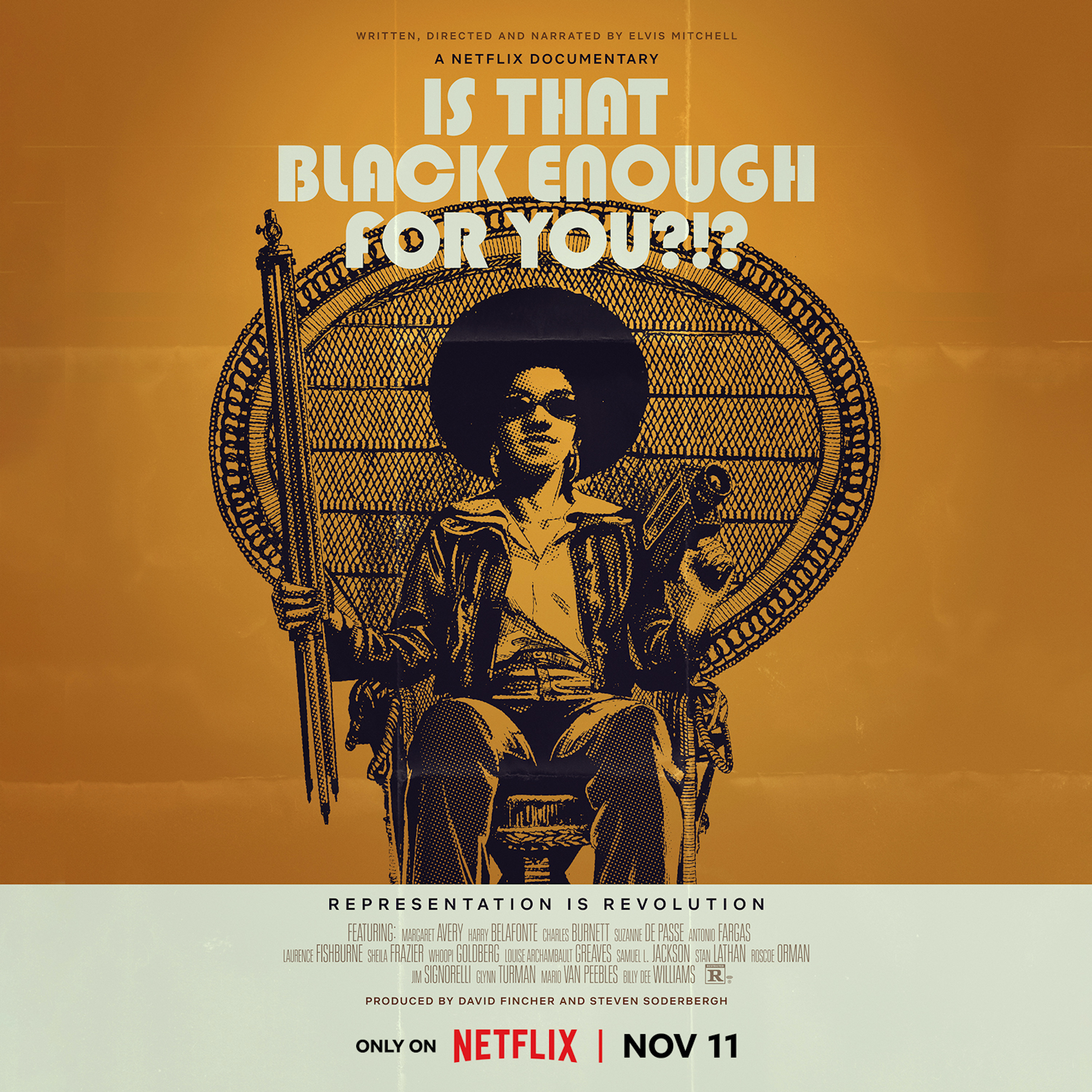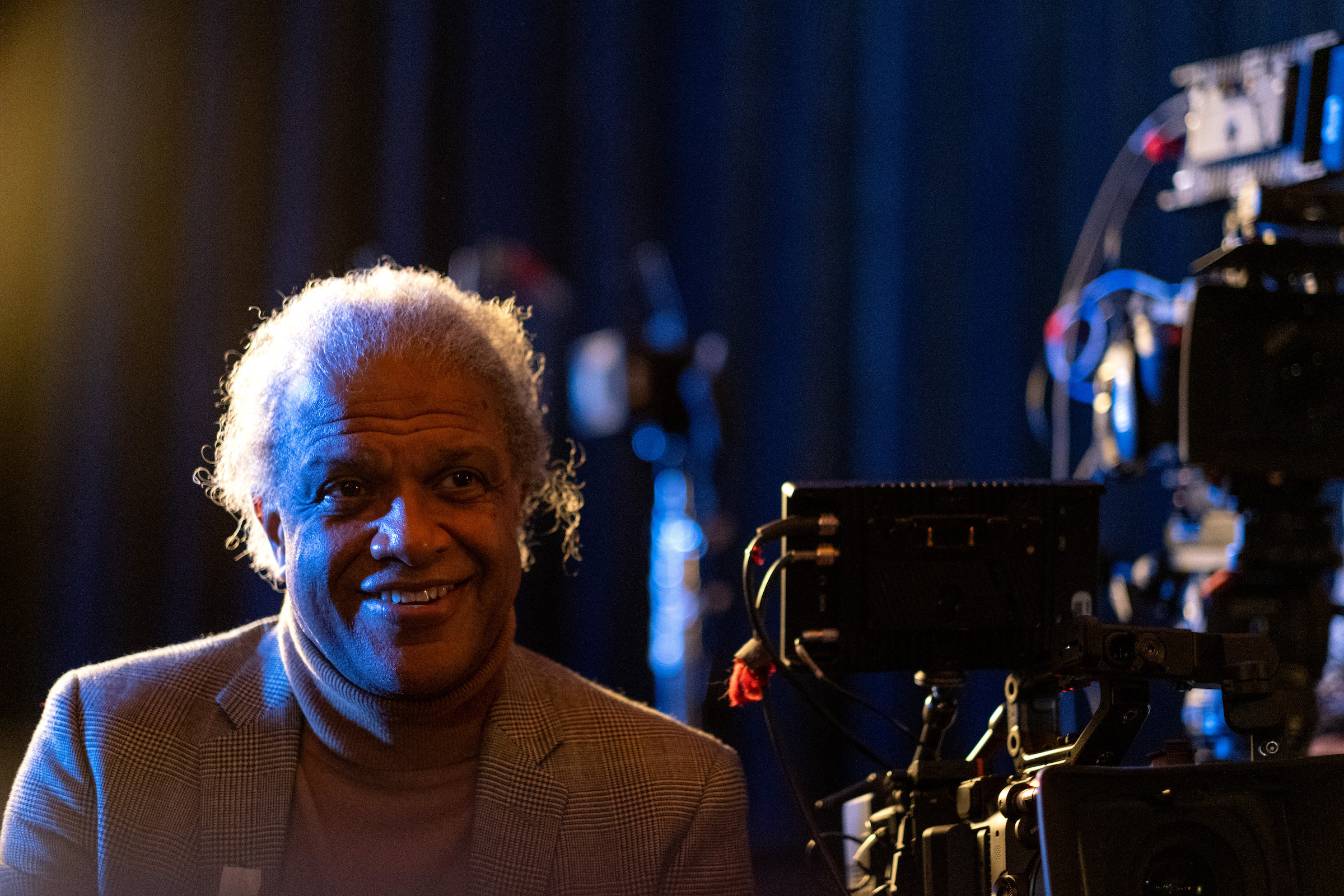
The documentary title Is That Black Enough For You?!? comes from many different sources.
The phrase is a reference to the 1970 film Cotton Comes to Harlem, co-written and directed by Ossie Davis. Davis, in turn, borrowed the saying from Black revolutionaries, writing it into the ballad Black Enough (Ain’t Now But It’s Gonna Be), sung by Tony winner Melba Moore over the film’s sunny opening credits.
In Cotton Comes to Harlem, con man Deke “Reverend” O’Malley (Calvin Lockhart) asks a cheering crowd “Am I Black enough for you?!” as he preaches. In another scene, Detective “Gravedigger” Jones (Godfrey Cambridge) drily asks “Is that Black enough for you?” in a completely different tone. Barry (Theodore Wilson) asks scavenger Uncle Budd (Redd Foxx) “Is that Black enough for you?” with a wink. “It ain’t, but it’s gonna be,” responds Uncle Budd.
A couple of years later, Kenny Gamble and Leon Huff, who later developed the Philadelphia soul genre, would write the song Am I Black Enough For You?, recorded by Grammy winner Billy Paul. And in 1989, Philadelphia rapper Schoolly D would title his fourth album Am I Black Enough For You? after his song by the same name, which samples the Billy Paul track.
The documentary Is That Black Enough For You?!?, released by Netflix on Friday, is a visual personal essay that has been marinating in the mind of the director and film historian Elvis Mitchell for years. Artists from throughout the ages—from Harry Belafonte and Charles Burnett to Samuel L. Jackson, Whoopi Goldberg, and Zendaya—share their insights into the industry in snippets of interviews. Mitchell wanted to examine a decade that forever changed both cinema and himself: Black film in the 1970s.
“Like so much of Black culture, it’s severely underestimated, reduced,” Mitchell says. “You would think that it’s nothing but Blaxploitation, Black action films that were campy and the people couldn’t act and the action sequences were badly staged. And none of that’s true.”
Another common misconception: The ‘70s, though remarkable, were not the first time that Black directors got to step behind the camera. Rather, the documentary clarifies, directors like Oscar Micheaux were hard at work as early as the 1920s—though they were denied access to Hollywood.
Mitchell grew up in this time, an unparalleled era in cinema that was infused with Black pride. He and his friends were going to a movie every week—and seeing something completely unexpected each time. For him, it was revelatory.
“It’s weird to be on the ground floor, because we now have innovation happen so often that we don’t even think about it anymore,” Mitchell says. Whereas in the ‘70s, “these things are happening in this de facto underground. This stuff wasn’t being covered in the mainstream.”
Here are six films—each featured in the documentary—Mitchell picked to highlight from this time period (including a couple of forerunners), accompanied by his reflections.—Laura Zornosa

Odds Against Tomorrow, 1959
The 1959 noir that should’ve made Harry Belafonte a movie star; instead, its failure drove him away from the screen for over a decade. And his ire is completely understandable—it’s a fast-moving but contemplative crime drama that alights on race, class, and sexuality, and treated its star as the sexual cynosure the world knew him to be; his presence as a down-on-his-luck jazz musician who has to turn to robbery (with a makeshift gang built around a bitter, misanthropic gangster played by Robert Ryan in a role that’s the ne plus ultra of his vitriolic, self-hating bottom feeders) is contrasted with the impact he makes walking into a room or even an elevator. Belafonte’s character’s rejection by the world at large (implicitly and explicitly because of his race) is the load-bearing wall that keeps this fascinating structure intact over 60 years later.—Elvis Mitchell
Symbiopsychotaxiplasm: Take One, 1968
Hilarious, sobering, and demanding simultaneously—writer, director, and star William Greaves turned a lifetime of studying movies from the inside into a deft and early piece of art that would now be called “meta.” Greaves began his career as an actor decades earlier and was increasingly appalled by the lack of opportunities and roles for people of color; he turned his life into this story of a film gone wrong in the hands of a director (Greaves) who doesn’t know what he wants but is determined to make a movie anyway. The ongoing misfires exhaust and frustrate his cast and crew. The sublime joke: Greaves is intentionally sabotaging the project to engage his co-workers with art and life in a way they never dreamed possible. We even get to witness—and endure—his pain with the secret he cannot reveal in this film that’s part fiction, part documentary and all original. Take One is inspirational and inspired—and, like so many other Black films—has created a text that is still being quoted today.—E.M.
Cotton Comes to Harlem, 1970
In which director Ossie Davis (with an able assist from co-writer Arnold Perl, who wrote the Malcom X biopic script with James Baldwin) turns Chester Hines’ dour, neo-noir detective novel into a free-wheeling and joyous fairy tale set in a uptown Manhattan that never existed. The story—NYPD detectives “Gravedigger” Jones (Godfrey Cambridge) and “Coffin Ed” Johnson (Raymond St. Jacques) treat Harlem as their own personal fiefdom and mete out justice as they see fit while on the trail of a larcenous would-be minister (Calvin Lockhart) who’s trying to fleece the area’s citizenry—is given a head-clearing breeziness through ingenious set pieces, glowing styles and a cast that features stage actors and other famous personages (it’s the screen debuts of Redd Fox and Cleavon Little, among others) whose pleasure in taking the screen spills onto the audience.—E.M.
Lady Sings the Blues, 1972
Even Diana Ross, in her starring debut, seems startled by the performance she gives as the tragic Billie Holiday in this 1972 biopic; she received a Best Actress Oscar nomination for the role. It’s shaped to her gifts, and to a hunger for Black glamor in the movies that had never been addressed, much less fed. It’s packed with star-making turns from a cast that included Richard Pryor—who so thoroughly owned the sections that he glided through in that the movie almost never recovers from his disappearance—and, in the first iteration of his “Dark Gable” streak, Billy Dee Williams, who left audiences swooning as he idles on sheer charisma and camera rapport. (Producer Berry Gordy recognized the Ross/Williams affinity, re-teaming them a few years later for Mahogany.)—E.M.
The Spook Who Sat By the Door, 1973
Ivan Dixon walked away from a successful acting career and put his future on the line to direct this potent adaptation of the equally subversive Sam Greenlee novel. Its paranoiac premise is culled from a nightmare scenario that could be stenciled on “Defund the CIA” protest placards—what if a Black man, recruited by the CIA and then shuttled off to a meaningless job as window dressing to seduce earnest liberals, drifted away from the agency and used its espionage training to train the disenfranchised and marginalized into a fighting revolution that takes over America, inner city by inner city? The film was so beautifully realized, especially by the nuanced and patient performance by Lawrence Cook at its center, that Dixon maintained “Spook” cost him his career.—E.M.
Killer of Sheep, 1978
A landmark achievement in ‘70s cinema, and as a scene study, one of the most influential films of the 20th century, writer-director Charles Burnett’s observant and discursive drama follows the day-to-day life of a working man trying to build a life for his family. From such simplicity, art is made. Burnett’s eye for emotional detail is unparalleled—with a minimum of dialogue, he created a lived-in world whose thriving idiosyncrasies allow each character to inhabit the movie in such a way that we know who they are as soon as we lay eyes on them; it could be compared to Italian neo-realism, yet is so deeply and richly American that such a reference ignores its honesty, vitality, and humor. It’s also that rare movie in which the kids exist in a believable and absorbing way without coming across as insufferable and burdensome. Never has a feature film directing debut displayed such mastery and yet received such short shrift.—E.M.
More Must-Reads From TIME
- The 100 Most Influential People of 2024
- The Revolution of Yulia Navalnaya
- 6 Compliments That Land Every Time
- What's the Deal With the Bitcoin Halving?
- If You're Dating Right Now , You're Brave: Column
- The AI That Could Heal a Divided Internet
- Fallout Is a Brilliant Model for the Future of Video Game Adaptations
- Want Weekly Recs on What to Watch, Read, and More? Sign Up for Worth Your Time
Contact us at letters@time.com